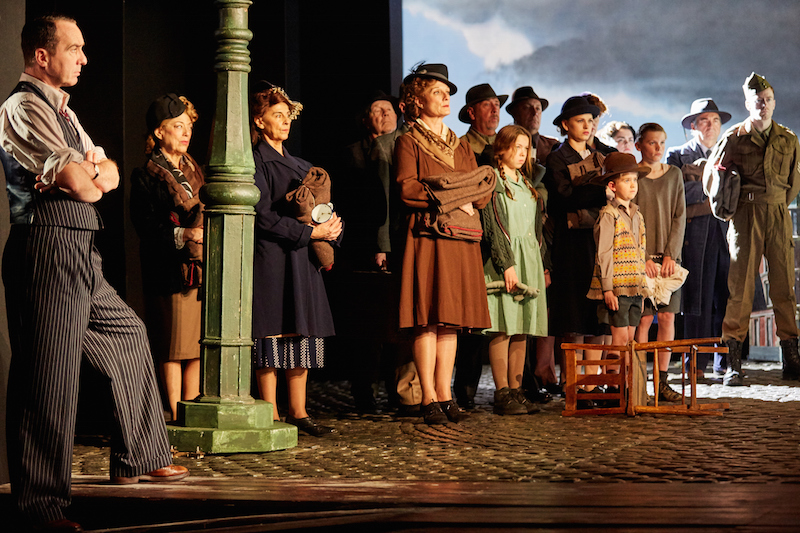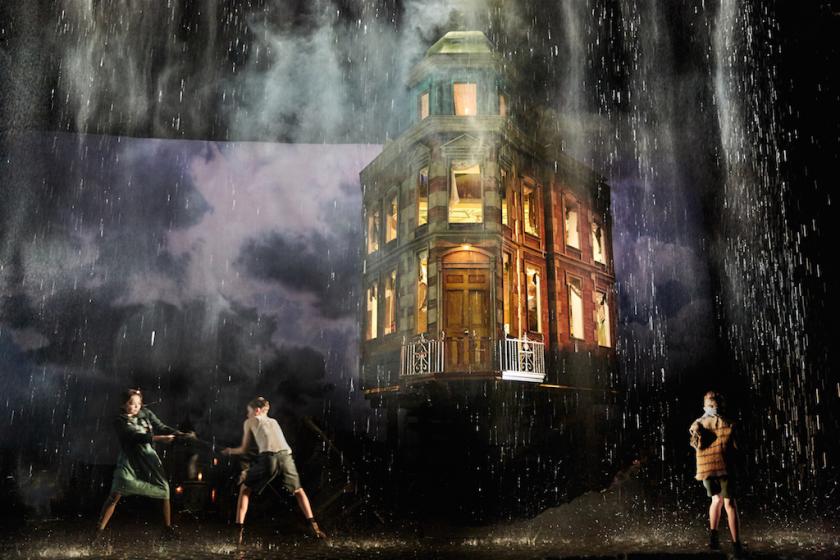So, the Inspector has come calling yet again. Twenty-four years have passed since Stephen Daldry’s graphic revision of JB Priestley’s moral tub-thumper opened at the National, followed by a tour of duty in the West End that seemed to go on forever. The Birling family house collapsed eight times a week at the Aldwych, the Garrick, the Novello and then Wyndhams, and set builders never had it so good.
Yet it would be wrong to assume that nothing about this production has changed in that time. For a start, its success has more or less finished off any possibility of staging this period drawing-room drama in a traditional way. More crucially, though, its field of reference has shifted. In 1992, when Daldry and his designer Ian MacNeil conceived their triple-layer time-shift reading, the “now” was a Thatcherite Britain awash with new money. This revival, with a fresh cast, plays in a Britain more riven, more fearful, more uncaring, than at any time since the play was written.
Without this production Priestley's play would by now be languishing in outer am-dramshire
The well-to-do Birling family are toasting the daughter’s engagement when an unexpected knock at the door shakes their self-satisfied world to its core. A young woman has been found dead after drinking bleach, and the visiting Inspector Goole (the clue’s in the name) wants to question each family member in turn. All deny knowledge of the girl, but gradually it transpires that each, unwittingly, has played a part in her demise.
Daldry’s big idea was to position these comfortable Edwardians and their home within the devastated urban landscape of the Blitz, 30 years later. It was social inequality, Priestley believed, along with capitalism’s gross disregard for working people, that had led to both world wars. Daldry additionally has the Inspector break the fourth wall to address the audience in the here and now. The message is clear: there is such a thing as society, and we all bear responsibility for one another.
Under the Victorian proscenium of the Playhouse, MacNeil’s realisation of the Birlings' house – a corner-plot gothic pile teetering on stilts – still makes a terrific impact when the curtain goes up. Around it lies the smoking wreckage of a rain-lashed English street after a visit from the Luftwaffe, behatted residents slowly emerging to gawp at the destruction. Within this anachronism, the 1912 family celebration half-audibly going on within its first-floor dining room registers a brittle disconnect. It’s a smart way on the director’s part of dealing with a less-than-fascinating bit of exposition.
Even smarter is the way the set physically impinges on the characters once the room’s hinged front wall – in the manner of a doll's house – has swung open to expose its residents. When daughter Sheila (Carmela Corbett), walks to the perimeter of the dining room, she has to take extreme care not to topple off the edge. When the industrialist Arthur Birling goes downstairs to meet the Inspector, he is obliged to insert a cast-iron baluster (a product of his own factory perhaps) to make the descent possible.
The production is full of such neat details, along with others that miss the mark. Midway through (there is no interval) Stephen Warbeck’s pre-recorded score – dominated by doomy cello – swerves into a direct quotation from Bernard Herrmann’s music for the film Vertigo, and you notice that the roundel of the Birlings' house has been lit (by Rick Fisher) to resemble the tower of the famous Spanish church in the climax of that film, from which the heroine hurls herself to her death. I’m still puzzling over that, as well as the curious moment when the Inspector (a testy Liam Brennan, pictured below, far left) peers up to the lighting box and calls proceedings to a temporary halt, as if he’s a film director calling “cut!”. Neither allusion is followed up.
 While it’s probably true that without this production JB Priestley’s play would by now be languishing in outer am-dramshire, it’s questionable whether it fully responds to Daldry’s treatment. It remains a clunky old formula, and we see the dénouement coming a long way off: it's hardly a "thriller" as advertised. Worse, the play’s moral reprimand now feels dated in its outspokenness. Ken Loach’s latest film, I, Daniel Blake, is didactic on a similar subject, but more oblique and infinitely more potent.
While it’s probably true that without this production JB Priestley’s play would by now be languishing in outer am-dramshire, it’s questionable whether it fully responds to Daldry’s treatment. It remains a clunky old formula, and we see the dénouement coming a long way off: it's hardly a "thriller" as advertised. Worse, the play’s moral reprimand now feels dated in its outspokenness. Ken Loach’s latest film, I, Daniel Blake, is didactic on a similar subject, but more oblique and infinitely more potent.
The cast cannot be faulted – we believe in every one of these people, at least as individual types. Whether they hang together as a plausible Edwardian family is debatable. Clive Francis is a standout as the smug northern ex-mayor who had hopes for a knighthood and Barbara Marten is magnificently imperious as his wife, but her Knightsbridge vowels do not belong in the same room. For all its noisy spectacle (the smashing glassware from the sliding dining table is quite something), Daldry’s An Inspector Calls neither moves us to pity nor leaves us with the resolve to behave better, which is surely what Priestley intended.
- An Inspector Calls is at The Playhouse Theatre to 4 February
- Read more theatre reviews on theartsdesk
STEPHEN DALDRY'S FINEST MOMENTS
Skylight. David Hare's domestic epic dazzles anew with Carey Mulligan and Bill Nighy
The Audience. Helen Mirren returns in triumph as Her Majesty
The Crown. So was it worth £100m? (Yes)
The London 2012 Opening Ceremony. Danny Boyle and Stephen Daldry dazzle
Trash. Three unknowns save the day
PLUS ONE TURKEY
Extremely Loud and Incredibly Close. Adaptation of Jonathan Safran Foer's novel is lacking in magic















Add comment